The Esophageal Implant Market is estimated to be valued at USD 167.4 billion in 2025 and is projected to reach USD 320.1 billion by 2035, registering a compound annual growth rate (CAGR) of 6.7% over the forecast period.
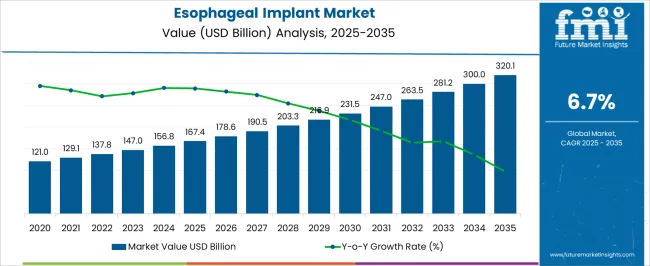
| Metric | Value |
|---|---|
| Esophageal Implant Market Estimated Value in (2025 E) | USD 167.4 billion |
| Esophageal Implant Market Forecast Value in (2035 F) | USD 320.1 billion |
| Forecast CAGR (2025 to 2035) | 6.7% |
The esophageal implant market is experiencing notable growth driven by the rising prevalence of gastroesophageal disorders, increasing adoption of minimally invasive surgical procedures, and growing awareness of advanced treatment options. An aging population and lifestyle factors such as dietary habits, obesity, and stress have contributed to a higher incidence of esophageal conditions.
Advancements in biocompatible materials and implant design are supporting improved patient outcomes, reduced recovery times, and fewer complications, thereby enhancing acceptance across healthcare settings. Regulatory approvals and ongoing clinical research are further strengthening confidence in the safety and efficacy of esophageal implants.
The future outlook remains strong as hospitals and specialized centers continue to integrate innovative implant solutions, aligning with the broader goals of patient-centric care and long-term disease management.
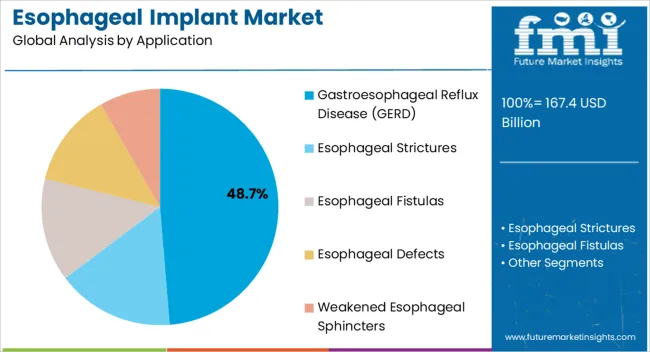
The gastroesophageal reflux disease segment is projected to account for 48.70% of total market revenue by 2025 within the application category, positioning it as the most significant segment. This dominance is driven by the increasing global incidence of GERD, which has become a leading chronic digestive condition.
Rising demand for durable and minimally invasive treatment solutions has accelerated the use of esophageal implants as effective alternatives to long-term medication. Improved implant technologies designed to restore normal esophageal function while minimizing adverse effects have further fueled adoption.
With a strong emphasis on improving patient quality of life and reducing dependence on pharmacological therapies, GERD remains the leading application driving segmental growth.
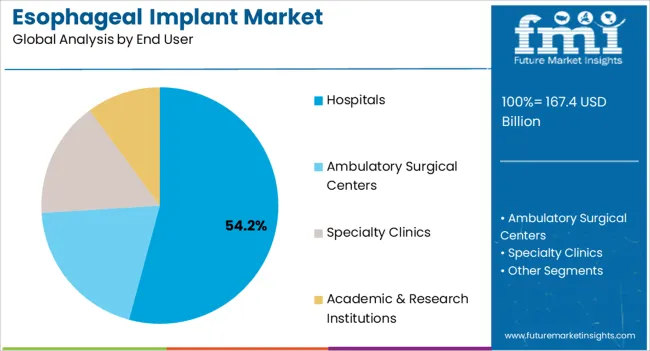
The hospitals segment is expected to capture 54.20% of total market revenue by 2025 under the end user category, establishing it as the dominant segment. Hospitals serve as the primary centers for diagnosis, surgical interventions, and post-procedural care, making them critical to esophageal implant adoption.
Their access to advanced surgical infrastructure, multidisciplinary expertise, and established reimbursement frameworks has supported higher procedure volumes. Additionally, hospitals are at the forefront of adopting innovative implant solutions supported by clinical research and medical collaborations.
Growing patient preference for specialized care settings, coupled with the availability of skilled professionals and advanced technologies, has reinforced the hospital segment’s leadership in this market.
Challenges for Companies /Manufacturers in the Esophageal Implant Industry:
Opportunities in the Esophageal Implant Industry:
Latest Trends in the Esophageal Implant Market:
According to Future Market Insights’ (FMI) latest report, global sales of esophageal implants increase at a CAGR of 5.6% from 2020 to 2025. Total market size reached USD 167.4 million in 2025.
From 2020 to 2025, the global esophageal implant industry witnessed steady growth due to the rising preference for esophageal implants for treatments.
Initially, surgery was the only option for treating tracheoesophageal fistula (TEF). Although this is still true for benign TEF and other disorders, implantation of esophageal implant is currently the preferred treatment for both malignant and benign TEF when surgery cannot be delayed.
Self-expanding metal stents (SEMS) have been the preferred stent since the mid-1990s, replacing hard plastic prostheses.
Looking ahead, the global esophageal implant industry is expected to rise at a CAGR of 6.7% from 2025 to 2035. During the forecast period, the market size is expected to reach USD 280.2 million.
Growth in the market is expected to be driven by rising cases of esophageal disorders, innovations in esophageal implants, and a strong desire for minimally invasive procedures.
Introduction of several medical innovations and rising demand for implants & therapies involving minimally invasive surgery will further boost the market.
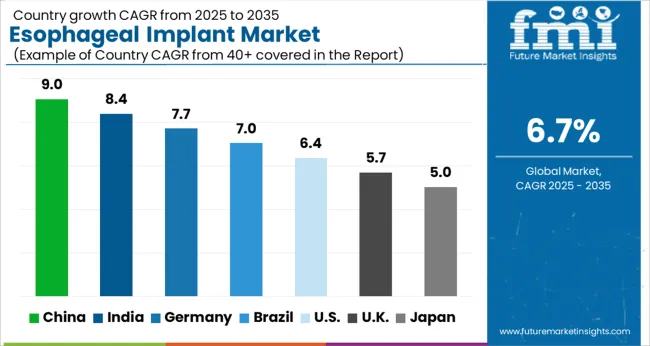
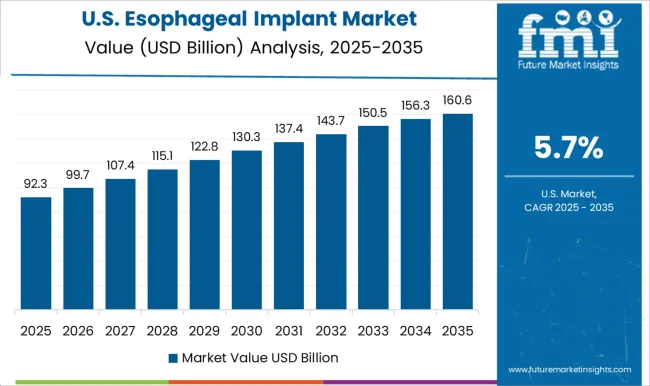
Growing Awareness Regarding Treatment of Esophageal Disorders Fueling Demand in the United States
| Country | United States |
|---|---|
| Market Size (USD million) by End of Forecast Period (2035) | USD 320.1 million |
| CAGR % from 2025 to End of Forecast (2035) | 7.3% |
As per Future Market Insights (FMI), the United States esophageal implant industry is expected to reach a valuation of USD 320.1 million by 2035. From 2025 to 2035, esophageal implant sales in the country are likely to surge at 7.3% CAGR.
The United States esophageal implant industry is predicted to expand due to the country's high knowledge of esophageal disease management and treatment. This encourages key firms to develop and launch new products, which will ultimately help them expand their market.
Favorable legislation, presence of significant esophageal stent suppliers, new product releases, and the use of cutting-edge technology are other factors boosting the United States market.
Similarly, rising cases of GERD is likely to elevate esophageal implant demand during the projection period.
Prevalence of Esophageal Cancers to Retain High Demand for Esophageal Stents the United Kingdom
| Country | The United Kingdom |
|---|---|
| Market Size (USD million) by End of Forecast Period (2035) | USD 14.11 million |
| CAGR % from 2025 to End of Forecast (2035) | 5.6% |
The United Kingdom esophageal implant industry is forecast to attain a valuation of USD 14.11 million by 2035. Total esophageal implant demand in China is projected to rise at 5.6% CAGR during the forecast period.
Growth in the market is expected to be driven by rising prevalence of esophageal cancer in the country.
Esophageal stents are eventually employed by doctors to open up a blockage caused by cancer. This aids in the relief of symptoms produced by the obstruction.
Increasing Cases of Dysphagia to Bolster Esophageal Implant Sales in China
| Country | China |
|---|---|
| Market Size (USD million) by End of Forecast Period (2035) | USD 21.34 million |
| CAGR % from 2025 to End of Forecast (2035) | 8.6% |
As per Future Market Insights (FMI), esophageal implant sales in China are anticipated to soar at 8.6% CAGR through 2035. Total market valuation in China at the end of 2035 is expected to reach USD 21.34 million.
The esophageal implant industry in China is likely to expand prominently due to the high prevalence of dysphagia.
Dysphagia is becoming more common in China, especially among the elderly and those who have had strokes. To treat this medical condition, esophageal implants such as stents are being used.
Rising Instances of Barrett’s Esophagus Disease to Elevate Esophageal Implant Demand in Japan
| Country | Japan |
|---|---|
| Market Size (USD million) by End of Forecast Period (2035) | USD 4.4 million |
| CAGR % from 2025 to End of Forecast (2035) | 7.5% |
Japan esophageal implant industry is estimated to reach a valuation of USD 4.4 million by 2035. It is likely to thrive at a CAGR of 7.5% during 2025 to 2035. The market in Japan is predicted to expand because of the increasing geriatric population.
Japan has one of the world's leading shares of geriatric population. The risk of esophageal disorders such as esophageal cancer, gastroesophageal reflux disease (GERD), and Barrett's esophagus increase with age. These diseases often necessitate surgery and the use of esophageal implants.
Increasing Government Support for Development of Medical Devices to Boost Korea Market
| Country | South Korea |
|---|---|
| Market Size (USD million) by End of Forecast Period (2035) | USD 0.7 million |
| CAGR % from 2025 to End of Forecast (2035) | 6.9% |
The Korea esophageal implant industry is poised to exhibit a CAGR of 6.9% during the projection period. Total market valuation in Korea is projected to reach USD 0.7 million by 2035.
The market in South Korea is forecast to witness robust growth due to favorable government support for product development. Through different initiatives and funding support, the South Korean government has aggressively fostered the development of the medical device industry.
Financial incentives, research grants, and tax breaks are available to enterprises engaged in medical device research and development. Because of the government's commitment to supporting innovation in the healthcare sector, both domestic and foreign enterprises have invested in medical device development.
Esophageal Stents to Create the Most Profitable Opportunities for Manufacturers
According to Future Market Insights (FMI), esophageal stents segment is expected to dominate the global market. It is likely to thrive at a CAGR of 6.0% from 2025 to 2035, making it a key revenue-generation segment.
Growth of the target segment is driven by rising usage of esophageal stents for treating various conditions due to their less postoperative difficulties.
Esophageal stents have become key tools for palliative treatment of inoperable esophageal malignancies. They are mostly placed in the esophagus to keep blocked areas open. These stents can also be used to treat conditions such as esophageal fistulas, strictures, leaks, and perforations.
Development of advanced stents by manufacturers to lower the operative risks in patients will further boost the target segment.
Leading esophageal implant manufacturers are introducing novel products that are safe and easy to use. For instance, BONASTENT is an esophageal stent product. It has an anatomically adjustable nitinol hook and cross-wire construction. Its outspread and returning forces are appropriate for excellent conformability.
Growing popularity of bioabsorbable stents is another factor that is expected to boost growth of the target segment.
Gastroesophageal Reflux Disease (GERD) Treatment Application to Lead the Market
Application in treatment of gastroesophageal reflux disease (GERD) is expected to dominate the esophageal implant industry, exhibiting a CAGR of 7.4% from 2025 to 2035. This is due to rising prevalence of GERD coupled with increasing usage of esophageal implants for treating this medical condition.
Numerous studies have found that one of the main causes of GERD disease is obesity or excess belly fat. Over 20% of persons in the United States suffer from GERD as a result of being overweight or obese. This in turn is likely to elevate esophageal implant demand during the assessment period.
Hospitals Remain the Leading End User of Esophageal Implants
As per the latest report, hospitals will remain the leading end-users of esophageal implants. The target segment is likely to progress at a CAGR of 7.1% from 2025 to 2035. This is due to the presence of high skilled professionals in the hospitals and rising patient inclination on getting treatments in hospitals.
Hospitals continue to be the most widely used setting for doing minimally invasive procedures for gastrointestinal diseases. The existence of cutting-edge infrastructure and qualified medical personnel is what drives demand for esophageal implants in hospitals.

The esophageal implant industry is highly competitive due to large presence of regional and local players. In such a scenario, companies must adopt effective strategies to stay ahead of the competition.
Key Strategies Adopted by the Players:
Product Innovation
Companies are investing rigorously in research and development to introduce new products with enhanced features. Product innovation enables manufacturers to differentiate themselves from their competitors and meet the evolving needs of customers.
Strategic Partnerships and Collaborations
Key players in the industry often form strategic alliances, collaborations, and partnerships with other companies to leverage their strengths and expand their reach in the market.
Expansion into Emerging Markets
The esophageal implant industry is witnessing significant growth in emerging markets such as China and India. Key esophageal implant manufacturers are expanding their presence in these markets by establishing local manufacturing facilities and strengthening their distribution networks.
Mergers and Acquisitions
Key esophageal implant companies are also adopting mergers and acquisitions to strengthen their market position, expand their portfolio, and gain access to new markets.
Key Players in the Esophageal Implant Industry:
Key Developments in the Esophageal Implant Industry:
| Attribute | Details |
|---|---|
| Estimated Market Size (2025) | USD 167.4 billion |
| Projected Market Size (2035) | USD 320.1 billion |
| Anticipated Growth Rate (2025 to 2035) | 6.7% CAGR |
| Forecast Period | 2025 to 2035 |
| Historical Data Available for | 2020 to 2025 |
| Market Analysis | USD million for Value and MT for Volume |
| Key Regions Covered | North America; Latin America; Europe; Asia Pacific; and Middle East and Africa |
| Key Countries Covered | United States, Canada, Mexico, Brazil, Germany, Italy, France, United Kingdom, Spain, BENELUX, Russia, China, Japan, South Korea, India, ASEAN, Australia and New Zealand, Türkiye, South Africa, GCC Countries, Others. |
| Key Segments Covered | Product, Application, End User, and Region |
| Key Companies Profiled | Boston Scientific; Medtronic; Cook Medical; Taewoong Medical; Micro-Tech (Nanjing) Co., Ltd.; Ella-CS; M.I. Tech; Merit Medical; Xlumena Inc.; Olympus Corporation; Johnson & Johnson; Apollo Endosurgery, Inc.; EndoStim; NDO Surgical, Inc; Mederi Therapeutics; Becton Dickenson & Company; Baxter International (Synovis Surgical Innovations) |
Product Innovation
Companies are investing rigorously in research and development to introduce new products with enhanced features. Product innovation enables manufacturers to differentiate themselves from their competitors and meet the evolving needs of customers.
Strategic Partnerships and Collaborations
Key players in the industry often form strategic alliances, collaborations, and partnerships with other companies to leverage their strengths and expand their reach in the market.
Expansion into Emerging Markets
The esophageal implant industry is witnessing significant growth in emerging markets such as China and India. Key esophageal implant manufacturers are expanding their presence in these markets by establishing local manufacturing facilities and strengthening their distribution networks.
Mergers and Acquisitions
Key esophageal implant companies are also adopting mergers and acquisitions to strengthen their market position, expand their portfolio, and gain access to new markets.
The global esophageal implant market is estimated to be valued at USD 167.4 billion in 2025.
The market size for the esophageal implant market is projected to reach USD 320.1 billion by 2035.
The esophageal implant market is expected to grow at a 6.7% CAGR between 2025 and 2035.
The key product types in esophageal implant market are gastroesophageal reflux disease (gerd), esophageal strictures, esophageal fistulas, esophageal defects and weakened esophageal sphincters.
In terms of end user, hospitals segment to command 54.2% share in the esophageal implant market in 2025.






Full Research Suite comprises of:
Market outlook & trends analysis
Interviews & case studies
Strategic recommendations
Vendor profiles & capabilities analysis
5-year forecasts
8 regions and 60+ country-level data splits
Market segment data splits
12 months of continuous data updates
DELIVERED AS:
PDF EXCEL ONLINE
Esophageal Catheters Market Size and Share Forecast Outlook 2025 to 2035
Transesophageal Echocardiography (TEE) Market
Gastroesophageal Reflux Disease (GERD) Device Market Analysis - Size, Share, and Forecast Outlook 2025 to 2035
Gastroesophageal Reflux Disease Therapeutics Market Analysis - Innovations & Forecast 2025 to 2035
Gastroesophageal Junction Adenocarcinoma Therapeutics Market by Drug, Diagnosis, Treatment, Distribution Channel, and Region through 2035
Animal Gastroesophageal Reflux Disease Market Size and Share Forecast Outlook 2025 to 2035
Implant-Borne Prosthetics Market Size and Share Forecast Outlook 2025 to 2035
Implantable Collamer Lens Market Size and Share Forecast Outlook 2025 to 2035
Implantable Defibrillator Market Size and Share Forecast Outlook 2025 to 2035
Implantable Infusion Pump Market Size and Share Forecast Outlook 2025 to 2035
Implantable Drug Eluting Devices Market Size and Share Forecast Outlook 2025 to 2035
Implantable Drug Infusion Pumps Market
Preimplantation Genetic Testing Market Size and Share Forecast Outlook 2025 to 2035
Bio-Implants Market Analysis - Size, Share, and Forecast Outlook for 2025 to 2035
Gel Implants Market Analysis - Trends, Share & Forecast 2025 to 2035
Peri-implantitis Treatment Market Trends – Demand & Future Outlook 2024-2034
Nasal Implant Market Size and Share Forecast Outlook 2025 to 2035
Smart Implants Market Size and Share Forecast Outlook 2025 to 2035
Brain Implants Market Size and Share Forecast Outlook 2025 to 2035
Cheek Implants Market

Thank you!
You will receive an email from our Business Development Manager. Please be sure to check your SPAM/JUNK folder too.
Chat With
MaRIA